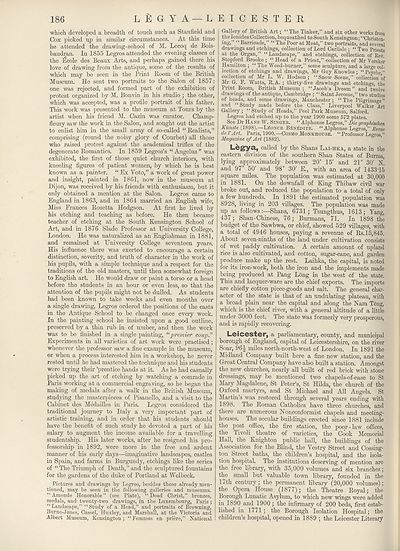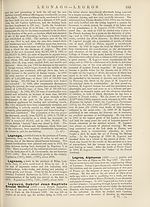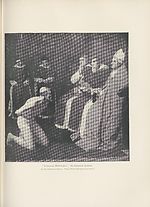New volumes of the Encyclopædia Britannica > Volume 30, K-MOR
(210) Page 186
Download files
Complete book:
Individual page:
Thumbnail gallery: Grid view | List view

186 L E G Y A — L
which, developed a breadth of touch such as Stanfield and
Cox picked up in similar circumstances. At this time
he attended the drawing-school of M. Lecoq de Bois-
baudran. In 1855 Legros attended the evening classes of
the l^cole des Beaux Arts, and perhaps gained there his
love of drawing from the antique, some of the results of
Avhich may be seen in the Print Boom of the British
Museum. He sent two portraits to the Salon of 1857:
one was rejected, and formed part of the exhibition of
protest organized by M. Bonvin in his studio ; the other,
which was accepted, was a profile portrait of his father.
This Avork was presented to the museum at Tours by the
artist Avhen his friend M. Cazin was curator. Champ-
fleury saw the work in the Salon, and sought out the artist
to enlist him in the small army of so-called “ Realists,”
comprising (round the noisy glory of Courbet) all those
who raised protest against the academical trifles of the
degenerate Romantics. In 1859 Legros’s “ Angelus” Avas
exhibited, the first of those quiet church interiors, with
kneeling figures of patient women, by which he is best
known as a painter. “ Ex Yoto,” a work of great power
and insight, painted in 1861, now in the museum at
Dijon, was received by his friends Avith enthusiasm, but it
only obtained a mention at the Salon. Legros came to
England in 1863, and in 1864 married an English wife,
Miss Frances Rosetta Hodgson. At first he lived by
his etching and teaching as before. He then became
teacher of etching at the South Kensington School of
Art, and in 1876 Slade Professor at University College,
London. He was naturalized as an Englishman in 1881,
and remained at University College seventeen years.
His influence there Avas exerted to encourage a certain
distinction, severity, and truth of character in the work of
his pupils, with a simple technique and a respect for the
traditions of the old masters, until then someAvhat foreign
to English art. He would draw or paint a torso or a head
before the students in an hour or even less, so that the
attention of the pupils might not be dulled. As students
had been known to take weeks and even months over
a single draAving, Legros ordered the positions of the casts
in the Antique School to be changed once every week.
In the painting school he insisted upon a good outline,
preserved by a thin rub in of umber, and then the work
was to be finished in a single painting, 11 premier coup”
Experiments in all varieties of art work were practised;
whenever the professor saAV a fine example in the museum,
or Avhen a process interested him in a workshop, he never
rested until he had mastered the technique and his students
were trying their ’prentice hands at it. As he had casually
picked up the art of etching by watching a comrade in
Paris working at a commercial engraving, so he began the
making of medals after a Avalk in the British Museum,
studying the masterpieces of Pisanello, and a visit to the
Cabinet des Medailles in Paris. Legros considered the
traditional journey to Italy a very important part of
artistic training, and in order that his students should
have the benefit of such study he devoted a part of his
salary to augment the income available for a travelling
studentship. His later works, after he resigned his pro¬
fessorship in 1892, Avere more in the free and ardent
manner of his early days—imaginative landscapes, castles
in Spain, and farms in Burgundy, etchings like the series
of “ The Triumph of Death,” and the sculptured fountains
for the gardens of the duke of Portland at Welbeck.
Pictures and drawings by Legros, besides those already men¬
tioned, may be seen in the following galleries and museums.
“Amende Honorable” (see Plate), “Dead Christ,” bronzes,
medals, and twenty-two draAvings, in the Luxembourg, Paris ;
“Landscape,” “Study of a Head,” and portraits of Browning,
Burne-Jones, Cassel, Huxley, and Marshall, at the Yictoria and
Albert Museum, Kensington; “Femmes en priere,” National
EICESTER
Gallery of British Art; “ The Tinker,” and six other works from
thelonides Collection, bequeathed to South Kensington; “Christen¬
ing,” “Barricade,” “ The Poor at Meat,” two portraits, and several
drawings and etchings, collection of Lord Carlisle ; “ Two Priests
at the Organ,” “Landscape,” and etchings, collection of Rev
Stopford Brooke ; “ Head of a Priest,” collection of Mr Yereker
Hamilton ; “ The Weed-burner,” some sculpture, and a large col¬
lection of etchings and drawings, Mr Guy Knowles; “Psyche”
collection of Mr L. W. Hodson ; “Snow Scene,” collection of
Mr G. F. Watts, R.A. ; thirty-five drawings and etchings, the
Print Room, British Museum; “Jacob’s Dream” and twelve
drawings of the antique, Cambridge ; “ Saint Jerome,” two studies
of heads, and some drawings, Manchester; “The Pilgrimage”
and “Study made before the Class,” Liverpool Walker Art
Gallery ; “ Study of Heads,” Peel Park Museum, Salford.
Legros had etched up to the year 1900 some 572 plates.
See Dr Haxs W. Singer. “Alphonse Legros,” Die graphischen
Kiinste (1898).—LkoNCE B^nAdite. “ Alphonse Legros,”
de VArt. Paris, 1900.—Cosmo Monkhouse. “Professor Legros ”
Magazine of Art (1882).
L&gya, called by the Shans Lai-hka, a state in the
eastern division of the southern Shan States of Burma,
lying approximately between 20° 15' and 21° 30' n!
and 97° 50' and 98° 30' E., with an area of 1433,15
square miles. The population was estimated at 30,000
in 1881. On the downfall of King Thibaw civil war
broke out, and reduced the population to a total of only
a few hundreds. In 1891 the estimated population was
8928, living in 203 villages. The population was made
up as follows Shans, 6731 ; Tsungthus, 1613; Yang,
437; Shan-Chinese, 76; Burmans, 71. In 1898 the
budget of the Sawbwa, or chief, showed 529 villages, with
a total of 4946 houses, paying a revenue of Rs.15,845.
About seven-ninths of the land under cultivation consists
of wet paddy cultivation. A certain amount of upland
rice is also cultivated, and cotton, sugar-cane, and garden
produce make up the rest. Laihka, the capital, is noted
for its iron-Avork, both the iron and the implements made
being produced at Pang Long in the west of the state.
This and lacquer-ware are the chief exports. The imports
are chiefly cotton piece-goods and salt. The general char¬
acter of the state is that of an undulating plateau, Avith
a broad plain near the capital and along the Nam Teng,
which is the chief river, with a general altitude of a little
under 3000 feet. The state was formerly very prosperous,
and is rapidly recovering.
Leicester, a parliamentary, county, and municipal
borough of England, capital of Leicestershire, on the river
Soar, 96 J miles north-north-west of London. In 1891 the
Midland Company built here a fine new station, and the
Great Central Company have also built a station. Amongst
the neAv churches, nearly all built of red brick with stone
dressings, may be mentioned tAvo chapels-of-ease to St
Mary Magdalene, St Peter’s, St Hilda, the church of the
Oxford martyrs, and St Michael and All Angels. St
Martin’s Avas restored through several years ending Avith
1898. The Roman Catholics have three churches, and
there are numerous Nonconformist chapels and meeting¬
houses. The secular buildings erected since 1881 include
the post office, the fire station, the poor - Uav offices,
the Tivoli theatre of varieties, the Cook Memorial
Hall, the Knighton public hall, the buildings of the
Association for the Blind, the Vestry Street and Cossing-
ton Street baths, the children’s hospital, and the isola¬
tion hospital. The institutions deserving of mention are
the free library, Avith 35,000 volumes and six branches;
the small but valuable toAvn library, founded in the
17th century; the permanent library (20,000 volumes);
the Opera House (1877); the Theatre Royal; the
Borough Lunatic Asylum, to which new Avings were added
in 1890 and 1900; the infirmary of 200 beds, first estab¬
lished in 1771; the Borough Isolation Hospital; the
children’s hospital, opened in 1889 ; the Leicester Literary
which, developed a breadth of touch such as Stanfield and
Cox picked up in similar circumstances. At this time
he attended the drawing-school of M. Lecoq de Bois-
baudran. In 1855 Legros attended the evening classes of
the l^cole des Beaux Arts, and perhaps gained there his
love of drawing from the antique, some of the results of
Avhich may be seen in the Print Boom of the British
Museum. He sent two portraits to the Salon of 1857:
one was rejected, and formed part of the exhibition of
protest organized by M. Bonvin in his studio ; the other,
which was accepted, was a profile portrait of his father.
This Avork was presented to the museum at Tours by the
artist Avhen his friend M. Cazin was curator. Champ-
fleury saw the work in the Salon, and sought out the artist
to enlist him in the small army of so-called “ Realists,”
comprising (round the noisy glory of Courbet) all those
who raised protest against the academical trifles of the
degenerate Romantics. In 1859 Legros’s “ Angelus” Avas
exhibited, the first of those quiet church interiors, with
kneeling figures of patient women, by which he is best
known as a painter. “ Ex Yoto,” a work of great power
and insight, painted in 1861, now in the museum at
Dijon, was received by his friends Avith enthusiasm, but it
only obtained a mention at the Salon. Legros came to
England in 1863, and in 1864 married an English wife,
Miss Frances Rosetta Hodgson. At first he lived by
his etching and teaching as before. He then became
teacher of etching at the South Kensington School of
Art, and in 1876 Slade Professor at University College,
London. He was naturalized as an Englishman in 1881,
and remained at University College seventeen years.
His influence there Avas exerted to encourage a certain
distinction, severity, and truth of character in the work of
his pupils, with a simple technique and a respect for the
traditions of the old masters, until then someAvhat foreign
to English art. He would draw or paint a torso or a head
before the students in an hour or even less, so that the
attention of the pupils might not be dulled. As students
had been known to take weeks and even months over
a single draAving, Legros ordered the positions of the casts
in the Antique School to be changed once every week.
In the painting school he insisted upon a good outline,
preserved by a thin rub in of umber, and then the work
was to be finished in a single painting, 11 premier coup”
Experiments in all varieties of art work were practised;
whenever the professor saAV a fine example in the museum,
or Avhen a process interested him in a workshop, he never
rested until he had mastered the technique and his students
were trying their ’prentice hands at it. As he had casually
picked up the art of etching by watching a comrade in
Paris working at a commercial engraving, so he began the
making of medals after a Avalk in the British Museum,
studying the masterpieces of Pisanello, and a visit to the
Cabinet des Medailles in Paris. Legros considered the
traditional journey to Italy a very important part of
artistic training, and in order that his students should
have the benefit of such study he devoted a part of his
salary to augment the income available for a travelling
studentship. His later works, after he resigned his pro¬
fessorship in 1892, Avere more in the free and ardent
manner of his early days—imaginative landscapes, castles
in Spain, and farms in Burgundy, etchings like the series
of “ The Triumph of Death,” and the sculptured fountains
for the gardens of the duke of Portland at Welbeck.
Pictures and drawings by Legros, besides those already men¬
tioned, may be seen in the following galleries and museums.
“Amende Honorable” (see Plate), “Dead Christ,” bronzes,
medals, and twenty-two draAvings, in the Luxembourg, Paris ;
“Landscape,” “Study of a Head,” and portraits of Browning,
Burne-Jones, Cassel, Huxley, and Marshall, at the Yictoria and
Albert Museum, Kensington; “Femmes en priere,” National
EICESTER
Gallery of British Art; “ The Tinker,” and six other works from
thelonides Collection, bequeathed to South Kensington; “Christen¬
ing,” “Barricade,” “ The Poor at Meat,” two portraits, and several
drawings and etchings, collection of Lord Carlisle ; “ Two Priests
at the Organ,” “Landscape,” and etchings, collection of Rev
Stopford Brooke ; “ Head of a Priest,” collection of Mr Yereker
Hamilton ; “ The Weed-burner,” some sculpture, and a large col¬
lection of etchings and drawings, Mr Guy Knowles; “Psyche”
collection of Mr L. W. Hodson ; “Snow Scene,” collection of
Mr G. F. Watts, R.A. ; thirty-five drawings and etchings, the
Print Room, British Museum; “Jacob’s Dream” and twelve
drawings of the antique, Cambridge ; “ Saint Jerome,” two studies
of heads, and some drawings, Manchester; “The Pilgrimage”
and “Study made before the Class,” Liverpool Walker Art
Gallery ; “ Study of Heads,” Peel Park Museum, Salford.
Legros had etched up to the year 1900 some 572 plates.
See Dr Haxs W. Singer. “Alphonse Legros,” Die graphischen
Kiinste (1898).—LkoNCE B^nAdite. “ Alphonse Legros,”
de VArt. Paris, 1900.—Cosmo Monkhouse. “Professor Legros ”
Magazine of Art (1882).
L&gya, called by the Shans Lai-hka, a state in the
eastern division of the southern Shan States of Burma,
lying approximately between 20° 15' and 21° 30' n!
and 97° 50' and 98° 30' E., with an area of 1433,15
square miles. The population was estimated at 30,000
in 1881. On the downfall of King Thibaw civil war
broke out, and reduced the population to a total of only
a few hundreds. In 1891 the estimated population was
8928, living in 203 villages. The population was made
up as follows Shans, 6731 ; Tsungthus, 1613; Yang,
437; Shan-Chinese, 76; Burmans, 71. In 1898 the
budget of the Sawbwa, or chief, showed 529 villages, with
a total of 4946 houses, paying a revenue of Rs.15,845.
About seven-ninths of the land under cultivation consists
of wet paddy cultivation. A certain amount of upland
rice is also cultivated, and cotton, sugar-cane, and garden
produce make up the rest. Laihka, the capital, is noted
for its iron-Avork, both the iron and the implements made
being produced at Pang Long in the west of the state.
This and lacquer-ware are the chief exports. The imports
are chiefly cotton piece-goods and salt. The general char¬
acter of the state is that of an undulating plateau, Avith
a broad plain near the capital and along the Nam Teng,
which is the chief river, with a general altitude of a little
under 3000 feet. The state was formerly very prosperous,
and is rapidly recovering.
Leicester, a parliamentary, county, and municipal
borough of England, capital of Leicestershire, on the river
Soar, 96 J miles north-north-west of London. In 1891 the
Midland Company built here a fine new station, and the
Great Central Company have also built a station. Amongst
the neAv churches, nearly all built of red brick with stone
dressings, may be mentioned tAvo chapels-of-ease to St
Mary Magdalene, St Peter’s, St Hilda, the church of the
Oxford martyrs, and St Michael and All Angels. St
Martin’s Avas restored through several years ending Avith
1898. The Roman Catholics have three churches, and
there are numerous Nonconformist chapels and meeting¬
houses. The secular buildings erected since 1881 include
the post office, the fire station, the poor - Uav offices,
the Tivoli theatre of varieties, the Cook Memorial
Hall, the Knighton public hall, the buildings of the
Association for the Blind, the Vestry Street and Cossing-
ton Street baths, the children’s hospital, and the isola¬
tion hospital. The institutions deserving of mention are
the free library, Avith 35,000 volumes and six branches;
the small but valuable toAvn library, founded in the
17th century; the permanent library (20,000 volumes);
the Opera House (1877); the Theatre Royal; the
Borough Lunatic Asylum, to which new Avings were added
in 1890 and 1900; the infirmary of 200 beds, first estab¬
lished in 1771; the Borough Isolation Hospital; the
children’s hospital, opened in 1889 ; the Leicester Literary
Set display mode to:
![]() Universal Viewer |
Universal Viewer | ![]() Mirador |
Large image | Transcription
Mirador |
Large image | Transcription
Images and transcriptions on this page, including medium image downloads, may be used under the Creative Commons Attribution 4.0 International Licence unless otherwise stated. ![]()
| Encyclopaedia Britannica > New volumes of the Encyclopædia Britannica > Volume 30, K-MOR > (210) Page 186 |
|---|
| Permanent URL | https://digital.nls.uk/193570231 |
|---|
| Attribution and copyright: |
|
|---|---|
| Shelfmark | EB.18 |
|---|---|
| Description | Ten editions of 'Encyclopaedia Britannica', issued from 1768-1903, in 231 volumes. Originally issued in 100 weekly parts (3 volumes) between 1768 and 1771 by publishers: Colin Macfarquhar and Andrew Bell (Edinburgh); editor: William Smellie: engraver: Andrew Bell. Expanded editions in the 19th century featured more volumes and contributions from leading experts in their fields. Managed and published in Edinburgh up to the 9th edition (25 volumes, from 1875-1889); the 10th edition (1902-1903) re-issued the 9th edition, with 11 supplementary volumes. |
|---|---|
| Additional NLS resources: |
|

